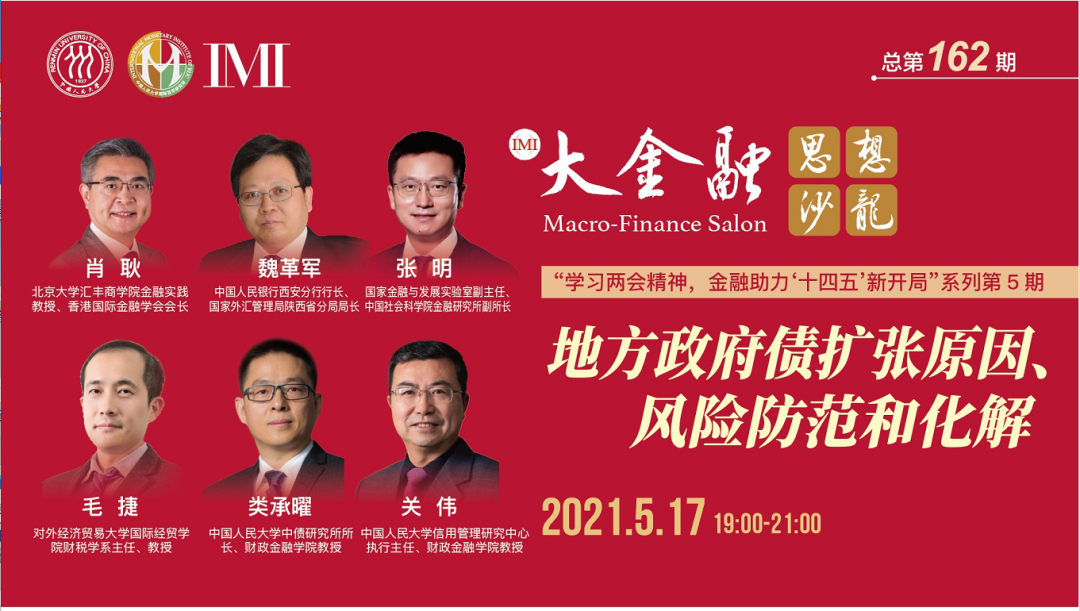Macro-Finance Salon (No. 162): Causes for Increasing Local Government Debt and Risk Prevention
2021-05-17 IMI
On May 17th, the fifth session of the series entitled “Finance Propels the Spening of the Fourteenth Five-Year Plan: Implementing the Principles of the Two Sessions”, an individual event of the Financial Salon, was successfully held through video conferencing. It was jointly organized by the Institute of International Monetary Studies of Renmin University of China and the Department of Monetary Finance of Renmin University of China. Lei Chengyao, Director of RUC’s Institute of Chinese Debt Research and professor at the Department of Fiscal and Finance, delivered a report entitled “Causes for Increasing Local Government Debt and Risk Prevention”.
The report received comments from:
Wei Gejun, Director of the Shaanxi Branch of the People’s Bank of China and Director of the State Administration Of Foreign Exchange;
Xiao Geng, professor Of Financial Practice of HSBC Business School of Peking University and President of Hong Kong Institute for International Finance;
Zhangming, Vice Director of The National Financial and Development Laboratory and Deputy Director of The Institute of Finance of the Chinese Academy of Social Sciences; and
Mao Jie, Vice Dean of The School of International Economics and Trade of The University of International Business and Economics.
The salon was moderated by Guan Wei, Executive Director of the Credit Management Research Center of the Renmin University of China.
Professor Lei Chengyao first delivered a thematic report entitled “Causes, Risks and Prevention of Rising Local Government Debt”. His key points are as follows:
In 2021, the central government is highly concerned about the risk of high local government debt. The 14th Five-Year Development Plan has made “resolving the hidden debt problems of local governments” a key objective for the next five years.
China's local government debt management policies can be divided into three stages: tentative management from 2014 to 2016; stringent management from 2017 to 2019; loosening up under the impact of COVID-19 in 2020; and a return to tight controls in 2021.
There are two main causes for local government debt. First, after the tax-sharing reform in 1994, there has been a misalignment between the administrative and the fiscal power for the local governments in relation to the central government. Local governments are short of fiscal resources for their administrative responsibilities. Second, local governments play a role in the economy. Therefore, government investment creates a demand gap for funds.
Local government debt is of three kinds: local government bonds, local hidden debt (including quasi-municipal bonds, or chengtouzhai) and contingent debt. Debt-to-GDP ratio, debt ratio and debt service ratio are often used indicators in studying local government debt. By the end of 2020, the gross debt-to-GDP ratio of China's local government was 45.8%, the debt ratio 97% and the debt service ratio was slightly more than 10%. All lower than the international red line. The overall risk of local debt in China is on the whole manageable, though structural conflicts are prominent. The risk of local government bonds debt is controllable and within a safe range, but the risk of hidden debt receives widespread concerns.
Measures to relieve the risk of local government debt mainly include:
1) reforming the fiscal and taxation system to redress the mismatch between the local government’s ever bigger expenditure responsibilities and their lack of fiscal powers;
2) more stringent debt management and restriction measures on local governments;
3) holding individuals accountable for illegal borrowing;
4) respecting the market force when incurring future debt;
5) expanding the local economy and bettering local government bond markets;
6) breaking the current mode of rigid compliance with the principal redemption (gangxing duifu) and improving mechanisms to ensure default on debt be met with market and legal consequences.
Professor Lei proposed that the situation of hidden debt can be relieved by:
1) replacing them with other financing vehicles such as government bonds and financial institutions rollovers, or by debt restructuring;
2) repaying them with, for example, government finance or project incomes;
3) declaring bankruptcy and liquidating the failed local financing vehicles, having the creditors bear the losses;
4) auxiliary measures, including integrating quasi-municipal bond issuers and establishing credit guarantee fund.
At present, the most commonly used ways to relieve government debt is by replacement and repayment.
Following the report, panelists discussed the rise and the risks of Chinese local government debt, the level and impact of local government debt, and how to resolve the issue.
Finally, in summarizing the salon, Professor Guan Wei recapped that the five experts and scholars have defined and discussed the concept of local government debt from the perspectives of macro and micro, theory and practice, central and local, qualitative and quantitative, and academic and industry. They also deeply examined the subjects of the debt’s macroeconomic effects, management on the medium- and micro-level, the features and developing trends of the market, and different systemic elements at play. He concluded by saying that the salon was an informative and inspiring event of full exchanges of views and insightful observations from the participants.
